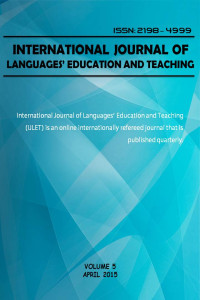ŞEYH GÂLİP’İN “ÂTEŞ” REDİFLİ GAZELİNİN DÜŞÜNCE ALANI MERKEZLİ METİN ÇÖZÜMLEME YÖNTEMİNE GÖRE ŞERHİ
Öz
Edebî metinler, yorumcuların farklı yollarla çözmeye çalıştıkları çoklu anlam içeren sanat eserleridir. Bu metinlere müellifler/şâirler yetiştikleri kültür ortamını ve bu ortamla şekillenen ruh zenginliklerini taşıdıkları için bunlarda her nesle hitap eden özel ve müşterek anlamlar gizlidir. İçerdiği anlamların ehli tarafından açıklanmasıyla derinlik kazanan şiir, sanatkârın bilgi birikiminin ve ruh zenginliğinin dil vasıtasıyla vücut bulmasıdır. Edebiyat yorumcusunun amacı, metne şâirin baktığı pencereden bakmaya çalışmak olmalıdır. Bu makalede Sebk-i Hindî üslûbunun önemli şâirlerinden olan Şeyh Gâlip’in “âteş” redifli gazeli, Ziya Avşar tarafından geliştirilen “Düşünce Alanı Merkezli” (DAM) metin çözümleme yöntemine göre şerh edilmiştir. Sebk-i Hindî üslûbunun önemli şâirlerinden olan Şeyh Gâlip, metafizik ağırlıklı şiirlerini soyut kelime düzeniyle ifade etmiştir. Ateş unsuru da şâirin sanat ve his dünyasında önemli bir yere sahiptir. Gâlip’teki ateş, hayalde mevcut olanla mevcut olmayanın birleştiği iki dünyadan gelen geniş bir anlam silsilesi telkin eder. Düşünce alanı merkezli yöntem, anlama yönelmesiyle geleneksel şerh yöntemine benzemektedir. Fakat metinde anlamlar arası bir düzen kurmasıyla da geleneksel yöntemden ayrılır. Şerh çalışmasında düşünce alanlarının tespiti çok önemlidir. Çünkü sanat sembollerle, olan ve olması gereken arasında sürekli iletişim hâlindedir. Bu yöntemde metinlerin çözümlenmesinde temel düşünce alanı, yardımcı düşünce alanı, birleşik düşünce alanı ve düşünce birimleri önem taşır. Yöntemin amacı, şiirdeki ince ve derin mânâların ölçülebilir hâle getirilmesidir.
Anahtar Kelimeler
Kaynakça
- İsmâîl Rüsûhî-yi Ankaravî, Mecmû’atu’l-Letâyif ve Matmûratu’l-Ma’ârif, C. II, Süleymaniye Kütüphanesi, Pertev Paşa 306.
- İsmâîl Rüsûhî-yi Ankaravî, Mecmû’atu’l-Letâyif ve Matmûratu’l-Ma’ârif, C. II, Süleymaniye Kütüphanesi, Hamidiye 670.
- İZUTSU, T. (2005). İbn Arabî’nin Fusûs’undaki Anahtar Kavramlar, (Çev. A. Y. Özemre), İstanbul: Kaknüs Yayınları.
- İZUTSU, T. (1995). İslâm’da Varlık Düşüncesi, (Çev. İ. Kalın), İstanbul: İnsan Yayınları.
- KALKIŞIM, M. (1994). Şeyh Gâlib Dîvânı, Ankara: Akçağ Yayınları. KILIÇ, A. (2009). “Geleneksel Şerh ve Modern Metin İncelemelerine Eleştirel Bir Bakış: Metotlar, Çalışmalar, Beklentiler”, Turkish Studies International Periodical For the Languages, Literature and History of Turkish or Turkic, Volume 4/6, s. 326-334.
- KONUK, A. A. (2005). Mesnevî-i Şerîf Şerhi (hzl.: O. Türer; M. Tahralı; S. Arpaguş), C. 3, İstanbul: Kitabevi Yay.
THE FIRE REPEATED WORD GHAZAL OF SHEIGH GÂLIP’S COMMENTARY ACCORDING TO METHOD OF THOUGHT ZONE BASED TEXT ANALYZING
Öz
Literary texts are works of art with multiple meanings that reviewers are trying to solve in many different ways. Authors/poets who have a cultural surroundings which have been reached and for having spirit riches which they shaped with this environment so in that way they inscribe into their texts many special and common hidden meanings, with intention to transfer them to the future generations. After discovering inner meanings in poetry, it becomes deeper, representing embodiment of artist’s knowledge and wealth of spirit through the meaning of the language. The main aim of literary reviewers should be observing the text from the author’s aspect. The poet that is “Ateş” rhyme ghazal, which was written by Şeyh Gâlip who is most important poets of Sebk-i Hindî’s style, has been commented according to method of “thought zone based text analyzing” (DAM) improved by Ziya Avşar in this article. Şeyh Gâlip, who is one of the most imortant poets of Sebk-i Hindî’s style specified his metaphysic poems with an abstract word order. The element of fire takes very important place in his world of art and sense. The element of fire in Gâlip’s poetry indicates a wide range of existing and non-existing meanings which originate from two different worlds and get united in imagination. Method of text analysis thought zone based text analyzing reminds of the traditional explanation methods. However, by establishing the order between meanings in text, this method separates from the traditional one. To find out of thought field is very important in comment. Because the art is being connected between the things that exist and those that should exist with symbols. In this method of text analyzing, the highest significance have main thinking domain, assistant thinking domain and combined thinking domain. The aim of this method is to make subtle and deep meanings accessible in poet.
Anahtar Kelimeler
Kaynakça
- İsmâîl Rüsûhî-yi Ankaravî, Mecmû’atu’l-Letâyif ve Matmûratu’l-Ma’ârif, C. II, Süleymaniye Kütüphanesi, Pertev Paşa 306.
- İsmâîl Rüsûhî-yi Ankaravî, Mecmû’atu’l-Letâyif ve Matmûratu’l-Ma’ârif, C. II, Süleymaniye Kütüphanesi, Hamidiye 670.
- İZUTSU, T. (2005). İbn Arabî’nin Fusûs’undaki Anahtar Kavramlar, (Çev. A. Y. Özemre), İstanbul: Kaknüs Yayınları.
- İZUTSU, T. (1995). İslâm’da Varlık Düşüncesi, (Çev. İ. Kalın), İstanbul: İnsan Yayınları.
- KALKIŞIM, M. (1994). Şeyh Gâlib Dîvânı, Ankara: Akçağ Yayınları. KILIÇ, A. (2009). “Geleneksel Şerh ve Modern Metin İncelemelerine Eleştirel Bir Bakış: Metotlar, Çalışmalar, Beklentiler”, Turkish Studies International Periodical For the Languages, Literature and History of Turkish or Turkic, Volume 4/6, s. 326-334.
- KONUK, A. A. (2005). Mesnevî-i Şerîf Şerhi (hzl.: O. Türer; M. Tahralı; S. Arpaguş), C. 3, İstanbul: Kitabevi Yay.
Ayrıntılar
| Birincil Dil | Türkçe |
|---|---|
| Konular | Türk Dili ve Edebiyatı (Diğer) |
| Bölüm | Araştırma Makalesi |
| Yazarlar | |
| Yayımlanma Tarihi | 30 Nisan 2015 |
| Yayımlandığı Sayı | Yıl 2015 Cilt: 3 Sayı: 1 |

